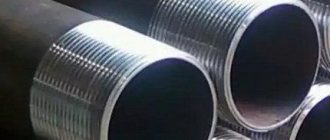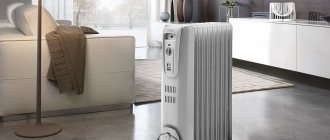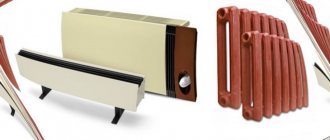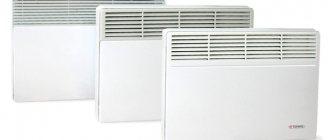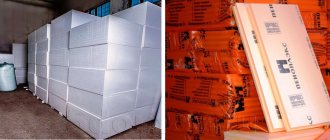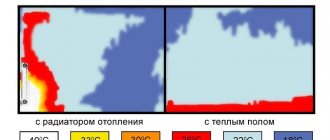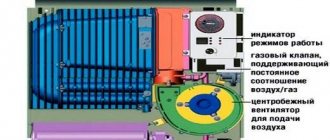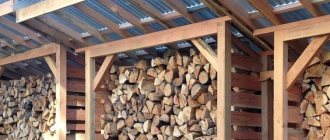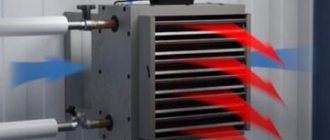What is better - a convector or a fan heater? comparative review
Published by Artyom on 04/22/2020 04/22/2019
In this article, we will look at what is better to buy: a fan heater or an electric convector, based on the main advantages and disadvantages of each product. Based on these parameters, we will draw our own conclusion, as well as several recommendations for choosing these types of electric heaters.
The design of fan heaters, their operating principle and features
These devices have a low price, which makes them accessible to a larger number of consumers. Devices of varying power are produced, which can vary widely. More powerful units are placed on the floor; devices with lower power are very compact and can be installed on various surfaces.
The operating principle of the fan heater is extremely simple. The device consists of a heating element and a fan that moves a large volume of air.
There are the following types of heating elements:
- Electric coil heating up to 800°C.
- Tubular electric heater with an operating temperature of about 200°C.
- Ceramic tiles with heating temperatures up to 200°C.
The cleanest air is provided by devices with a ceramic heating element. Fan heaters of other designs, especially those with an open spiral, pollute the air with their combustion products. Heating devices can also cause an unpleasant odor that occurs when debris and dust get on the heating element. This is also most common for devices with an open coil, especially given their high heating temperature.
The advantages of fan heaters are:
Operating principle of the fan heater
- Low price.
- Compact dimensions, even for high power devices.
- The speed of heating the air and its uniform distribution throughout the room.
- Elegant design that allows the device to be built into almost any room.
- Possibility of performing additional functions.
One of the disadvantages of the device is its noisy operation. This especially applies to high-power installations that operate at full load. Another disadvantage is the unpleasant odor mentioned above, which is typical for the cheapest models.
Trusted manufacturers of fan heaters are the following brands: Ballu, Bork, Climate, De'Longhi, General, Electrolux, NeoClima, Polaris, Rolsen, Saturn, Scarlett, Supra, Timberk.
You can also use these tips when purchasing:
- Models with ceramic heating elements are better in operation, although they are more expensive.
- Devices that have a sponge filter on the rear panel that performs rough cleaning keep the air clean.
- The optimal power of a household appliance is from 1 to 3 kW; for ease of use it should be smoothly adjustable.
- It is recommended to purchase devices with a well-thought-out safety system, with protection against overheating and equipped with automatic shutdown when tipped over.
Main characteristics of convectors
Most often, such devices are used to create heating in a house or apartment. This is due to the fact that the connection is made directly to the network, which requires creating a layout diagram for each of the products for effective operation.
Convectors are better because they have a longer service life, do not dry out the air and do not drive dust around the room. Everything is quite simple - cold air enters through the holes at the bottom of the heater and leaves by gravity through the upper technological grids.
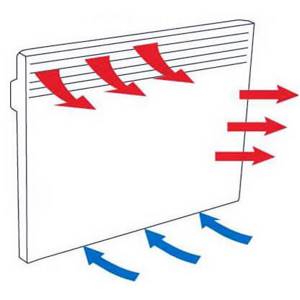
If we take into account the safety of the devices, then there are no problems here. This is due to the high level of fire and electrical safety. The only obstacle due to which this heating option may not be used is long-term heating of the room to the optimal temperature (about 2-3 hours). In addition, heaters are expensive.
We immediately recommend viewing more detailed information on choosing an electric convector for home heating!
Video presentation of the advantages of a modern convector
The design of convectors, its operating principle and features
A convection heater also heats the air, but its movement occurs through natural convection and not forced. Cold air enters the unit from below, passes through the heater and exits from the top. After this, the air is distributed throughout the room also due to natural processes.
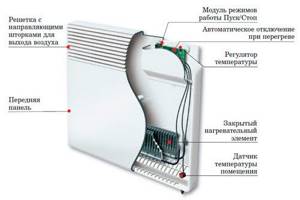
Convection heater device
There are different types of convectors available - floor-mounted, wall-mounted and combined. Floor-standing units have wheels for easy movement. When placing the convector on the wall, it is recommended to place it a few centimeters above the floor. This will ensure the best heating for the room. If the device is used in a bathroom or other rooms with high humidity, then you should pay attention to the electrical and moisture protection class . Devices built into the floor have a somewhat special design.
The advantages of convectors are as follows:
- Ability to work for a long time.
- Several ways of placing in the room.
- The presence of thermostats that allow you to maintain a certain temperature in the room.
- Possibility of combining devices into a heating system;
- Safety of use.
- Quiet operation.
The only significant drawback of converter heaters is the slow heating of the air in the room. This is due to the limited possibilities of natural convection.
The following convector manufacturers have proven themselves to be the best: ADAX, Ballu, Electrolux, Eltron, NeoClima, Nobo, Noirot, Polaris, Stiebel, Termor, Timberk. When choosing, it is recommended to pay attention to models with a thermostat that can determine the temperature with an accuracy of 1°C.
For domestic purposes, heaters with a power of 0.25-25 kW are used. You should also inquire about the maximum heating temperature of the case. For devices intended to operate in a children's room, it should be limited to 55-60°C.
Once you become familiar with the types of heating devices and their features, you can make an informed choice. If the device requires quick and short heating, then a fan heater will be optimal. If you need to operate the device for a long time, you should purchase a convector. It is recommended to select a model based on the technical characteristics of the product.
Useful tips
Models with a ceramic heating element are more expensive. But they perform much better in operation.
In the store, look at the back panel of the device. If you see a sponge filter for coarse cleaning, then know that the air in the room will be much cleaner.
The optimal power of the device is from 1 to 3 kW. In order for the device to be easy and convenient to use, the power must be adjusted smoothly.
Read more: Filling bathtub or acrylic liner – which is better?
It makes sense to buy devices that have a well-thought-out security system. It should provide protection against overheating and will automatically turn off the device if it is suddenly knocked over.
A fan heater should be used to dry cottages after winter or in small rooms with drafts. The device is convenient when there is a need to warm up the room frequently and quickly.
Enterprises produce models of various types - gas, electric, water. However, practice has shown that electric convectors are more often on sale. These are the ones that Russian buyers prefer.
Gas or water models are also in demand. They are bought by those who have a house or dacha outside the city. These devices are less suitable for an apartment.
When choosing a device, pay attention to products under the brand of well-known manufacturers. It makes sense to choose a model with an electronic thermostat. After all, it will control temperature changes. Moreover, with an accuracy of 1 degree.
Electric convectors are very good for a small room with low or standard ceilings. When the ceiling height exceeds three meters, a fan heater is better. Better yet, several fan heaters. Then they will quickly warm the air and mix it. And as a result, strong cooling will not occur.
Convectors with a power from 0.25 to 2.5 kWe are good for home use. The power depends on the area of the room. There is a reason to find out in the store the heating temperature of the case. Let's say, to work in a children's room, the case needs to heat up to 55 degrees.
Comparison of the capabilities of a convector and a fan heater
You can create a cozy and warm atmosphere in your home without even relying on central heating services - for heating it will be enough to purchase the appropriate equipment. Among them, convectors and fan heaters have gained some popularity. Both devices are on an equal footing: very often it is difficult for potential users to make a choice. Really, which is better – a convector or a fan heater?
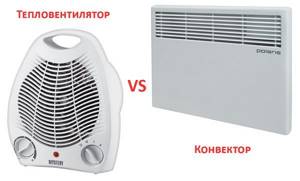
Fan heater
If you look from a technical point of view, it is difficult to understand what is the difference between these devices: they both “drive” air using its circulation. Warm flows go up from the unit and displace cold ones down - and so it goes in a circle. However, there are still differences. The fan heater is easy to operate and affordable for most consumers. This device can be found in the following versions:
- desktop;
- with placement on the floor;
- ceiling modification;
- "thermal curtains".

The work goes like this: a fan forces air through the heating element, from where it is heated and enters the space. There are different modifications of the main part:
- electric spiral heated to 800 degrees;
- ceramic tiles with the ability to heat up to 200 degrees;
- tubular heater with the same temperature.
Of all those mentioned, the models that have received the greatest praise are those that have a ceramic heating element - in this case, the heat is supplied in a “pure” form, without combustion byproducts.
Advantages of the device
There are many advantages that a fan heater device has.
- Warm-up speed. If you choose the right power, you can achieve a warm atmosphere in just a few minutes.
- Compact and mobile. These two combinations allow you to move small appliances from room to room to warm up the room where it is needed.
- Affordable price. The criterion speaks for itself - such goods do not stay on store shelves for a long time.
- Different temperature modes - you can choose the one you need.
- It is possible to choose a design suitable for your interior.

A fan heater, for example, is good for drying a dacha after the winter season. It will find another worthy application in rooms with drafts.
Disadvantages of this technique
There are also certain disadvantages:
- During operation there is quite a noticeable noise.
- If dust particles get on the open coil, an unpleasant odor cannot be avoided.
When purchasing a fan heater, you should give preference to devices that have a sponge filter with coarse cleaning (located at the back) . The power of the equipment ranges from 1 to 3 kW. It is worth paying attention to special protective functions: shutdown when overheating and when the device overturns.
Convector
This heater warms the air in the room as follows:
- Cold masses go inside through a grate located at the bottom of the product.
- After passing through the heater element, the air becomes warmer and exits through the grille on the top panel. The flow is then smoothly distributed in space.
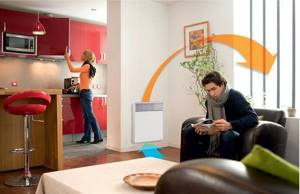
Many of the device models have a moisture protection class (marked as IP24), which allows them to be used in bathrooms and saunas.
Types of convectors are classified as follows:
Among the advantages of the technology, users note the following points:
- quick heating of the air in the room;
- fire safety;
- different mounting options;
- built-in thermostats (you can set the required temperature level);
- the ability to create a network of several devices (this solution will heat the entire house);
- no noise;
- operational safety;
- interesting and original design;
- duration of service.
Even this technique has its drawbacks. Since heating occurs by natural convection, the room may not heat up quickly enough. For the same reason, it will be difficult for a heater of this type to heat a high room. Also, this technique is very afraid of voltage surges, and in case of drafts, malfunction is possible.

All this leaves an imprint on the choice of models with certain thermostat capabilities (preferably, it can regulate the temperature exactly to the degree).
Making the right choice
When asking which is better: a convector or a fan heater, you should focus on the following selection criteria:
- If you plan that the equipment will work for years, then it is better to choose a convector. It can also heat several rooms well at once (if connected to a network). The decisive advantage will be the presence of a thermostat in the model, which will allow you to set the temperature.
- When the goal is to quickly warm up a room over a short period of time, it is worth choosing a fan heater.
- It would be even more interesting to duplicate the operation of both autonomous heating systems: first, the fan heater will warm the air in the room, then the convector will get to work, which will maintain the required temperature.
Which is better: a convector or a fan heater?
Heating equipment today offers a wide range of choices. Electric heaters are indispensable when periodic heating of the air is needed (for example, at a summer cottage, where the owners come for the weekend or in winter, when there is not enough heat from the radiators).
Both fan heaters and convectors are actively used today for various premises. The question “which is better: a fan heater or a convector” is easy to answer after comparing their characteristics.
A fan heater is the simplest and cheapest option. The device, as the name suggests, supplies heated air using a fan. The device quickly provides the required temperature in a small zone.
Main differences:
- Compact dimensions;
- Mobility;
- Low price;
- Various installation options (wall-mounted, floor-mounted, table-top);
- Ability to maintain a set temperature;
- Do not install in rooms with high humidity.
The fan cannot be the main source of heat, only an additional one. In addition, dust may settle on the heating element, which will give off a specific odor.
In a convector, heating occurs due to air circulation. Often used in places where heat loss is greatest (for example, next to a window or on a loggia). Convectors can be electric or gas. The heating speed is lower than that of fan heaters, so in an unheated room the desired temperature can be achieved within several hours.
Main advantages:
- Quietness (unlike fan heaters);
- Fire safety;
- High environmental friendliness;
- More uniform heating;
- Possibility of combining several convectors into a system with a single control (for full heating of the house);
- Can be floor or wall mounted;
- Can be installed in rooms with high humidity;
- Can be left unattended for a long time.
From a comparison of the characteristics, it is clear that a fan heater is more suitable for quick and short-term heating of a room; for long-term and more efficient operation, it is better to purchase a convector.
Whatever you choose, focus on the main parameter of any heater - power. On average, heating a room with normal thermal insulation requires 70-100 W per 1 m² of area.
What type of heating device is better to choose?
It all depends on the goals of the owner of the premises. If you need to achieve uniform heating of the entire area, and speed is not important, then it is better to install a convector. If the main goal is to obtain a directed flow of hot air and instant heating of a specific area in the room, a fan heater would be the best choice.

You can easily install a fan heater in your home office or office. The measured hum of the blades will not interfere, but will only help you concentrate, cutting off external sound stimuli
In residential premises, convectors are often installed due to the lack of noise, and for an office, where there is always some sound, a fan heater is appropriate.
Which is better, a convector or a fan heater: a comparative review of units
When choosing a heater, any person becomes somewhat confused by the number of models sold by heating equipment manufacturers on the market. The great popularity of modern fan heaters among buyers is explained quite simply. These inexpensive household appliances are capable of warming up the air in a room in a short time of operation, thereby providing a comfortable microclimate for the people there. Convectors built into the floor and hung on the wall will take a little longer to achieve the same result. But convector heaters can work longer, providing adequate heating for a small country house. To make a meaningful choice of equipment, you need to become more familiar with both types of heaters. Then it will become clear which is better: a convector or a fan heater.
Design and principle of operation of the fan heater
Electric fan heaters are considered the simplest and most affordable heating devices for most consumers. Floor-standing and tabletop models are available. The fan, driving a large volume of air through the heating element, provides rapid heating of the room. The heating element can be made in the form of:
- open electric spiral (operating temperature - 800°C);
- tubular electric heater (200°C);
- ceramic tiles (less than 200°C).
It is better to purchase fan heaters with a ceramic heating element, since these models provide “clean heat”. The air is not polluted by combustion products.

The latest models of fan heaters will not only provide quick and uniform heating of the room, but will also become an excellent element of interior decoration
The undoubted advantages of fan heaters include: their efficiency, minimal price, speed and uniformity of distribution of heated air throughout the room, compact size, elegant design and integration into any interior, the presence of additional functions and mobility.
The disadvantages of using these household appliances include increased noise that appears when the engine operates at high speeds. An unpleasant odor that occurs when combustion of dust and debris gets onto the open heating coil also causes inconvenience.
When going to the store, you can only trust the many years of consumer experience:
- Choose fan heaters produced by the following manufacturers: Electrolux, De'Longhi, Ballu, Rolsen, Polaris, Timberk, Supra, Bork, NeoClima, General Climate, Saturn, Scarlett.
- Pay attention to the type of heating element, give preference to models with “ceramics”.
- Buy devices with a coarse sponge filter installed on the back panel of the device.
- Consider the power of the household appliance (from 1 to 3 kW) and the presence of a function to regulate it.
- Safe operation of the device (overheating protection, automatic shutdown when tipped over).
